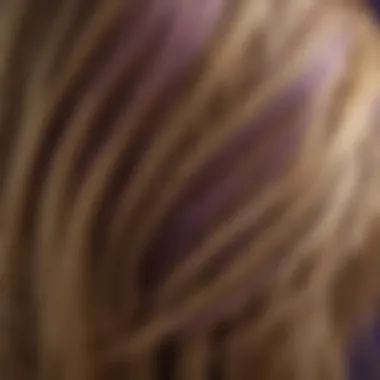The Impact of Purple Shampoo on Brassy Hair


Intro
Brassiness in hair, particularly for those with blonde, silver, or highlighted tones, is a common concern. This article will explore the various dimensions surrounding the use of purple shampoo as a solution to combat these unwanted warm tones. The relevance of this topic resonates with many individuals seeking to maintain their hair's vibrancy and aesthetic appeal.
Purple shampoo has gained widespread popularity due to its unique formulation, designed to neutralize brassy undertones. Understanding the causes of brassiness is crucial, as it helps users appreciate the effective roles that these shampoos play. We will delve into the science behind purple shampoo, examining how it functions at a chemical level and why it is particularly effective for certain hair types. Furthermore, unveiling the before-and-after effects can provide tangible evidence of its efficacy.
In the sections that follow, we will also cover best practices for application, recommended frequency of use, and considerations for different hair types. The aim is to equip readers with comprehensive knowledge, enabling informed choices in their hair care routines.
Understanding Brassy Hair
Brassy hair can be a significant concern, particularly for those who invest time and resources in coloring their hair. This section delves into brassy hair, exploring its definition, the common hair types that experience this issue, and the various causes that contribute to its appearance. Understanding these elements provides a foundation for addressing the problem with purple shampoo and other solutions.
Defining Brassiness in Hair
Brassiness refers to unwanted warm tones that can develop in colored or highlighted hair. These tones are usually described as yellow, orange, or golden. They often emerge following hair bleaching or coloring, leading to a less desirable shade that contrasts sharply with the intended hue. For many, maintaining a cool or neutral tone is essential, as it helps in achieving a polished and intentional look.
Common Hair Types Affected by Brassiness
Brassiness predominantly affects specific hair types. Those with blonde or light-colored hair are particularly susceptible to this issue, especially after highlighting. In addition, individuals with gray or silver hair may also experience brassiness as the color fades, shifting towards a warmer tone. Even previously brown hair that has been lightened can show brassiness over time. This shared vulnerability highlights the necessity of understanding how brassiness occurs to better manage it.
Causes of Brassy Hair
Brassiness can be attributed to several factors, which are crucial in understanding solutions like purple shampoo. Here are the main causes:
Chemical Treatments
Chemical treatments play a significant role in the development of brassiness. When hair is bleached, it removes the natural pigment. However, it can also leave behind yellow or orange undertones. These treatments are often harmful to the hair, making it more porous and susceptible to environmental influences. Therefore, while chemical treatments are popular for achieving lighter shades, they carry the risk of brassiness, making proper maintenance vital.
Environmental Factors
Environmental factors also contribute to brassiness. Elements such as sun exposure, chlorine, and pollution can alter hair color. Sunlight can cause a natural lightening effect in some cases but can also enhance brassy tones. Chlorine, commonly found in pools, is notorious for creating unwanted warm hues in lighter hair. Being aware of these factors can help individuals take preventive measures to protect their hair from environmental damage.
Hair Care Products
Lastly, the hair care products one uses can influence brassiness. Many shampoos and conditioners contain harsh ingredients that strip away color and pigments. Using products not specifically designed for color-treated hair can exacerbate the brassiness issue. Consequently, selecting the right hair care products becomes essential in maintaining the desired shade.
By examining these elements—definition, common affected hair types, and causes—consumers can gain a deeper understanding of brassiness in hair. This knowledge serves as a crucial step prior to exploring the effectiveness of purple shampoo in combating this prevalent issue.
An Overview of Purple Shampoo
Understanding purple shampoo is essential in the context of hair care, especially for individuals struggling with brassy tones. This section will detail what purple shampoo is, the underlying science, and its key ingredients. Each element plays a role in reducing brassiness, making it a valuable tool for many.
What Is Purple Shampoo?
Purple shampoo is a specialized hair cleaning product formulated to combat unwanted yellow and golden tones in blonde, gray, or color-treated hair. It contains purple pigments that are designed to neutralize brassiness, making hair appear more vibrant and cooler in tone. For those who often change their hair color or have recently lightened their locks, incorporating purple shampoo can help maintain a fresh look between salon visits.
The Science Behind Purple Shampoo
Color Theory
Color theory is a crucial concept for understanding how purple shampoo works. In simple terms, it explains that colors are opposite on the color wheel will neutralize each other. Therefore, purple is opposite to yellow. This means that applying a product with purple pigments directly targets and neutralizes the undesired brassiness in hair. This characteristic makes purple shampoo a popular choice among hair care enthusiasts seeking to retain the integrity of their lighter hues.
The unique feature of color theory lies in its simplicity and effectiveness. The advantage is clear: it helps in achieving a more balanced hair color effortlessly.
Neutralization Process


The neutralization process refers to how these purple pigments interact with the hair. When purple shampoo is applied, the pigments penetrate the hair shaft, neutralizing the warm tones. This process is critical for maintaining the desired cool tones in blonde or highlighted hair.
A key characteristic of this neutralization process is its direct action on unwanted tones, making it a beneficial choice for anyone needing to adjust their color without more drastic measures. However, being too vigorous in applying it can lead to over-correction, resulting in a purple tint to the hair.
Ingredients in Purple Shampoo
Sulfates
Sulfates are cleansing agents commonly found in many shampoos, including purple varieties. Their main function is to create lather while removing dirt and oil from the hair and scalp. Sulfates help ensure that the purple pigments are distributed evenly during washing.
The main advantage of sulfates is their efficacy in cleaning. However, their strong nature could also be a disadvantage, especially for individuals with sensitive hair or scalp conditions.
Conditioning Agents
Conditioning agents are included to help mitigate the drying effects of shampooing. They work by coating the hair, making it smoother and easier to manage. In purple shampoos, these agents also help ensure that the purple pigments do not leave hair feeling brittle or coarse.
Their presence is beneficial because they maintain hair's health while correcting brassiness. However, not all conditioning agents are created equally, and some may not work well with every hair type.
Color Pigments
Finally, color pigments are the star players in purple shampoo. These pigments are specifically designed to provide the purple hue that targets brassiness. Their formulation allows them to attach to the hair while cleansing, ensuring that the results are both immediate and visually appealing.
The most notable advantage of color pigments is their effectiveness. They quickly neutralize unwanted tones and enhance the hair’s overall appearance. On the flip side, some users may experience color build-up if used excessively, leading to unwanted shades.
In summary, understanding the elements behind purple shampoo is crucial for anyone looking to manage brassy hair effectively. Its ingredients not only aim to improve hair color but also maintain overall hair health.
Before-and-After Analysis of Purple Shampoo Usage
The before-and-after analysis of purple shampoo usage plays an essential role in understanding its impact on brassy hair. This section establishes a clear picture of how the product can significantly alter the appearance of hair, helping individuals appreciate the tangible benefits it offers. A visual representation along with personal experiences provides compelling evidence to support the claims made regarding purple shampoo.
Visual Evidence of Transformation
Visual evidence is a powerful tool in demonstrating the effects of purple shampoo on brassy hair. Before-and-after images often illustrate stark contrasts that are difficult to dispute. People searching for solutions can relate visually to the transformation.
Research shows that purple shampoo has the potential to neutralize unwanted yellow and orange tones, providing a cooler, more vibrant color. These images often serve as a source of inspiration for readers. It presents a real-life application of the product, making it relatable.
- Before Images: Often depict dull, warm tones that characterize brassy hair.
- After Images: Typically showcase transformed hair, displaying cooler and more even tones.
"Imagery can speak volumes. They show results that words alone might not convey."
User Testimonials
User testimonials represent a rich source of subjective data regarding the effectiveness of purple shampoo. Many users share experiences that highlight not only the immediate results but also the longer-term benefits. Testimonials usually include details about hair texture, ease of application, and overall satisfaction.
- Individuals often report noticeable improvement after just one or two washes.
- Some users have expressed that they noticed a decrease in brassiness over time, enhancing the longevity of their hair color.
- Others emphasize the pleasant scent and how it complements their hair care routine.
These first-hand accounts foster a sense of connection between the product and its intended users, making it easier for potential customers to trust the claims being made.
Expert Opinions on Results
Expert opinions add a layer of credibility to the discussion about purple shampoo. Hairstylists and colorists provide insights based on their professional experience. Many have shared their perspective on how purple shampoo can be a valuable part of a hair care regimen, particularly for those with color-treated or naturally blonde hair.
- Experts often recommend purple shampoo for regular use to maintain hair color.
- They might point out that while it effectively combats brassy tones, proper technique is paramount to achieve desired results.
- Many professionals state that purple shampoo can be an integral tool in achieving and maintaining healthy, vibrant hair.
Application Techniques for Optimal Results
Applying purple shampoo correctly is crucial to achieve the desired effects and maintain healthy hair. Effective application not only enhances the shampoo's performance but also minimizes potential adverse effects. This section breaks down the best practices to maximize the benefits of purple shampoo while addressing hair care needs.


How to Apply Purple Shampoo
To begin, wet hair thoroughly before applying the shampoo. This prepares the hair cuticles to absorb the product effectively. Use a generous amount of shampoo and distribute it evenly throughout your hair. Focus on the areas most prone to brassiness, such as the mid-lengths and ends. It's equally important not to apply it solely to the scalp, as it can lead to uneven results. Gently massage the shampoo into the hair using your fingertips. This helps to activate the formula and ensures that the purple pigments are spread evenly. It is vital to avoid overly vigorous scrubbing, as it can cause hair breakage.
Duration of Application
Timing is essential when using purple shampoo. The optimal duration for leaving the shampoo in hair varies based on individual hair types and conditions. Generally, five to ten minutes suffices for most people, but those with severe brassiness might benefit from a slightly longer period of about fifteen minutes. It's advisable to start with a shorter duration and assess the results to prevent potential over-toning, which can lead to a purplish hue.
Tip: For those new to purple shampoo, timing can be divided into trial phases. After the initial week of use, evaluate the tonal results before adjusting the duration.
Post-Application Care
Post-application care plays a significant role in maintaining hair health and color. After rinsing out the purple shampoo, applying a conditioner is essential. This helps to hydrate the hair and secure its integrity. Choose a conditioner tailored for color-treated hair to maximize benefits. Additionally, consider using a deep conditioning treatment once a week. This precaution is especially relevant for hair that experiences frequent use of color-correcting products.
Regular maintenance of hair post-purple shampoo is not just about hydration but also repairing any potential damage from color treatments.
By integrating these application techniques, individuals can expect optimal results with their purple shampoo. It is essential to incorporate research-based methods that enhance the functionality of the shampoo while reducing risks associated with misuse.
Frequency of Use
Understanding the frequency of use for purple shampoo is crucial for achieving optimal results, without compromising hair health. A balanced application rate is essential to maintain desirable hair tones while preventing potential drawbacks. This section will explore how often purple shampoo should be used, as well as the signs that may indicate overuse.
How Often Should You Use Purple Shampoo?
The frequency with which you should use purple shampoo depends on various factors including hair type, color, and specific needs related to combating brassiness. For those with blonde, silver, or highlighted hair, it is often recommended to use purple shampoo once or twice a week. This allows for effective toning without excessive buildup on the hair.
If your hair tends to become brassy quicker due to environmental factors or high levels of chemical processing, consider increasing the usage to about three times a week. However, focus on making adjustments based on results and your hair's condition.
Utilizing purple shampoo in moderation is key; heavy use can lead to unwanted undertones. Always pair it with a good conditioner to maintain moisture and health in the hair.
Signs You Are Overusing Purple Shampoo
Identifying the signs of overusing purple shampoo is important to protect the integrity of your hair. If you notice any of the following, it may be time to reassess your usage:
- Dryness: Hair may feel brittle or overly dry after washing.
- Excessive Tonal Changes: Hair might develop a purplish hue or off-tone rather than achieving a natural blonde or silver look.
- Breakage: Increased hair breakage or split ends can be a result of excessive use of toning products.
- Scalp Sensitivity: If you experience irritation or sensitivity on your scalp, this can indicate that the product is too harsh when used frequently.
By being mindful of the application frequency, you can utilize purple shampoo effectively, ensuring it enhances your hair color without causing damaging effects.
"Choosing the right frequency for purple shampoo use is essential for maintaining beautiful, balanced hair color."
Considerations for Different Hair Types
When dealing with the challenges of brassy hair, it is essential to recognize that hair types vary significantly in texture, color, and treatment history. Each type demands distinct care strategies, particularly when integrating products like purple shampoo into the regimen. Understanding these considerations ensures users achieve optimal results in neutralizing unwanted tones while maintaining hair health.
Color-Treated Hair
Color-treated hair is significantly susceptible to brassiness due to the chemical processes involved in color application. Whether it is highlighting, dyeing, or bleaching, the hair cuticle is often damaged, making it more prone to environmental factors that can contribute to unwanted yellow or orange undertones. Purple shampoo works effectively for this hair type by targeting the brassiness and neutralizing it. Regular use can prolong the vibrancy of the color and reduce the frequency of touch-ups needed. However, it is crucial to balance how often one uses purple shampoo with moisturizing treatments to avoid drying out the hair.
Natural Blonde Hair
Individuals with natural blonde hair face unique challenges when it comes to maintaining their color. While blonde shades are often beautiful and radiant, they can also attract brassiness from daily activities, such as sun exposure and chlorinated water. Purple shampoo can help maintain the brightness of natural blonde locks by counteracting the warm tones that may arise. Blondes should use this product judiciously, ideally incorporating it into their wash routine once or twice a week. Overuse may lead to a dull or overly ashy appearance, stripping the hair of its natural luster. Therefore, careful attention to the frequency and formulation congruence is paramount.
Gray or Silver Hair
Gray or silver hair presents a special case in the fight against brassiness. As hair loses its pigment, it often takes on a yellowish tint. Purple shampoo serves as an excellent remedy for this issue, as it contains specific pigments designed to neutralize these unwanted tones. It can enhance the coolness of gray and silver hair, making it appear more vibrant and shiny. However, the frequency of purple shampoo application will depend on the individual's hair condition and wash routine. Users must be cautious not to overdo it, as excessive use can lead to a purple hue on the hair strands. It is advisable to consistently monitor hair health and adjust usage accordingly for desired outcomes.


Potential Risks and Side Effects
In exploring the use of purple shampoo, it is essential to understand the potential risks and side effects associated with its application. While purple shampoo can significantly help in neutralizing brassiness, it is not without its drawbacks. Knowing these risks allows users to make informed decisions and adapt their hair care routines accordingly.
Allergic Reactions
Some users may experience allergic reactions to purple shampoo. This occurs due to sensitivity to certain ingredients found in the product. Typical symptoms can include itching, redness, or swelling on the scalp or surrounding skin. It is advisable to conduct a patch test prior to full application. This entails applying a small amount of shampoo on a less visible part of the skin and awaiting any reaction over 24 hours.
To minimize risks, read the label carefully and be aware of specific components like fragrances and colorants. Some natural formulations may offer alternatives with fewer irritants. If an allergic reaction does occur, stop using the product immediately and consult with a dermatologist for further guidance on safe hair care options.
Impact on Hair Texture
Using purple shampoo too frequently can negatively influence hair texture. Users may notice their hair becoming drier or more brittle after prolonged use. This is often a result of harsh sulfates and other cleansing agents that strip natural oils essential for maintaining moisture.
To preserve the softness and luster of hair, consider the following tips:
- Balance Usage: Limit the use of purple shampoo to a few times a week rather than daily.
- Hydration: Incorporate conditioning treatments to restore moisture post-wash.
- Product Selection: Choose purple shampoos with added hydrating ingredients like oils or botanical extracts.
"While purple shampoo is effective, excessive use can lead to unwanted dryness. Users should be cautious and assess their hair's needs."
By being aware of these potential side effects and adjusting application habits accordingly, individuals can enjoy the benefits of purple shampoo without compromising the health of their hair.
Alternative Products and Solutions
The significance of alternative products and solutions in combating brassy hair cannot be overstated. While purple shampoo is a popular option for many, it might not work for everyone. Understanding the available alternatives enables users to create a more personalized hair care routine, addressing individual needs more effectively. This section discusses different options that can help in reducing brassiness, their benefits, and important considerations to keep in mind when choosing alternatives.
Other Color-Correcting Shampoos
In addition to purple shampoo, there are several other color-correcting shampoos that target specific color-related issues. Here are a few noteworthy products:
- Blue Shampoo: This is particularly beneficial for those with blonde, light brown, or highlighted hair. Blue pigments neutralize orange and yellow tones, making it suitable for darker shades with warm undertones.
- Silver Shampoo: Designed for gray or silver hair, this product contains violet pigments that enhance the shine and brightness of silver locks. It helps in countering any yellow or brassy tones that may develop over time.
- Green Shampoo: For those dealing with red undertones, green shampoos can neutralize unwanted brassiness effectively. They are especially useful for individuals with color-treated or naturally red hair who want to tone down warm hues.
These alternatives often come with their own set of instructions regarding frequency and application, making it crucial for users to find the right match to their individual hair type.
Natural Remedies for Brassiness
For individuals seeking natural alternatives to chemical products, various home remedies can help in managing brassiness. Consider the following natural solutions:
- Apple Cider Vinegar: This can act as a natural toner, effectively balancing pH while removing residue from styling products. Mix equal parts of apple cider vinegar and water, apply to hair after shampooing, and rinse thoroughly.
- Chamomile Tea Rinse: Chamomile tea can enhance blonde tones while reducing yellowing. Steep chamomile tea bags in hot water, let it cool, and use it as a rinse after shampooing.
- Baking Soda: A mild abrasive, baking soda can help in gently exfoliating the hair and scalp while removing build-up. Mix with water to create a paste and apply to hair for a few minutes before rinsing.
- Coconut Oil Treatment: This natural oil is not only good for hydration but can also enhance shine. Apply to dry hair, leave it for an hour or overnight, and then wash it out. This may help in maintaining a more balanced hair color.
Utilizing natural remedies can be a gentle approach to minimizing brassiness, though results may vary based on individual hair types and conditions.
“Natural remedies do not offer instant results, but they can contribute to healthier, more balanced hair when used consistently.”
End and Final Thoughts
The examination of purple shampoo highlights its significance in addressing brassy hair. Understanding the importance of purple shampoo goes beyond mere color correction; it aids individuals in maintaining their desired hair shade while promoting healthier hair. By systematically analyzing the common causes of brassiness, one gains insight into how products like purple shampoo function to neutralize unwanted tones. This awareness plays a crucial role in not only aesthetic value but also in fostering self-confidence among users.
Summarizing the Effectiveness of Purple Shampoo
Purple shampoo has proven to be an effective solution for many dealing with brassy hair. Its formulation is designed to counterbalance yellow or orange tones, instilling a more vibrant appearance. Users often report visible improvements after consistent use.
- The science behind its effectiveness lies in color theory, where purple is opposite yellow on the color wheel.
- The lathering action helps deliver the pigments evenly across the strands.
- Regular application can significantly reduce brassiness, making hair look cooler and fresher.
"Purple shampoo can transform the overall look of hair, restoring its intended tone and brilliance."
Encouraging Informed Choices in Hair Care
Empowering individuals to make informed choices in their hair care routines is paramount. Knowledge about hair types, suitable products, and best practices can transform hair care from a mundane routine into a beneficial practice.
- Research is essential: Understanding the ingredients in purple shampoo can help users select suitable products.
- Customization is key: Tailoring the use of purple shampoo based on hair type provides optimal results.
- Avoiding pitfalls: Users must be cautious of overusing these products, as this can lead to undesired effects.
Promoting education on hair health can lead to better decisions, allowing individuals to maintain their hair color and texture effectively.



